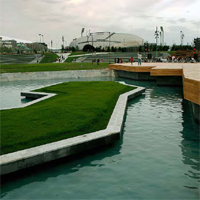Traces in the Landscape. Re-interpreting the Linear Infrastructure
DOI:
https://doi.org/10.6092/1970-9870/208Abstract
The gap between the infrastructure project and landscape design, between engineering works and quality of urban space, is a fact. The causes of poor integration are different, between these the indifference of the spaces of mobility with regard to nature and the stratification of places, the poverty figurative of many design solutions, the concept of a space transport as an element strictly monofunctional that usually does not integrate different uses and activities, as a purely technical solution to the shape of the city, almost never designed as an element of the regeneration of landscape, but as an exclusive place of movement and crossing. The infrastructure project is combined with the search for a new spatial quality, when the technical and morphological solutions conceive infrastructure not as an isolated element, foreign or superimposed on the context, but as part of the process of construction-regeneration of the landscape. In particular, the project for the rehabilitation and re-functionalization of linear infrastructures can become an opportunity to re-establish significant relations/interactions between parts of the city and territory, for the redevelopment and enhancement of places where the cultural and historical heritage and the landscape are a substantial source. The theme of inclusion of linear infrastructure in the landscape is declined in the following paragraphs by examining some experiences already implemented or being planned, extreme cases chosen according to their symbolism and the specific context, to assess the application and testing of innovative architectural designs and new planning proposals in areas which, although are confronted with problems related to lack of infrastructure and needs in the functional reorganization, appear to be highly stratified and places with substantial value and identity. The aim is to bring out the complexity of the search for design solutions for infrastructure that intersect very different situations and contexts (relations between “linear system”, “figures” and “sections”) where it is necessary to put together technical and constructive solutions with historical and/or morphological singularity, or infrastructure that represent and express themselves (also with the architectural choices) the context through enhancing the landscape, or infrastructure where is dominant the issue “perceptual”, the dynamic component or dimension of time, etc.
Downloads

Downloads
Published
How to Cite
Issue
Section
License
Authors who publish in this journal agree to the following:
1. Authors retain the rights to their work and give in to the journal the right of first publication of the work simultaneously licensed under a Creative Commons License - Attribution that allows others to share the work indicating the authorship and the initial publication in this journal.
2. Authors can adhere to other agreements of non-exclusive license for the distribution of the published version of the work (ex. To deposit it in an institutional repository or to publish it in a monography), provided to indicate that the document was first published in this journal.
3. Authors can distribute their work online (ex. In institutional repositories or in their website) prior to and during the submission process, as it can lead to productive exchanges and it can increase the quotations of the published work (See The Effect of Open Access)

